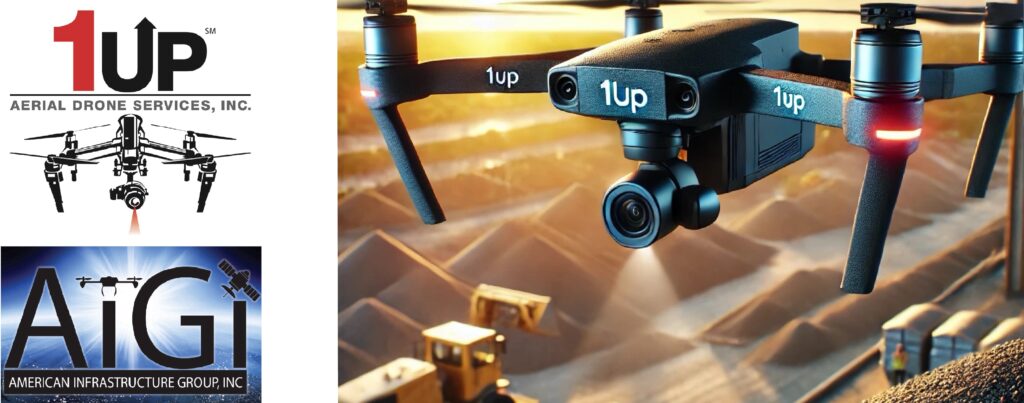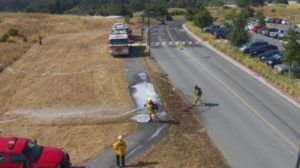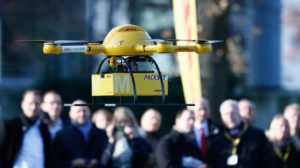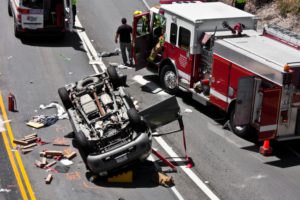Understanding the Current Standard for Remote ID in Drones and Why It’s Being Implemented
1Up Aerial Drone Services, Inc., a subsidiary of American Infrastructure Group, Inc. – December 2024
In recent years, drones have evolved from niche gadgets used by hobbyists to essential tools for various industries, ranging from agriculture and construction to photography and delivery services. As drone usage has proliferated, so have concerns about safety, privacy, and regulatory oversight. One of the most significant developments in drone regulation has been the introduction of *Remote ID*, a system designed to enhance airspace safety and accountability for drone operators. In this blog, we will explore what Remote ID is, why it is being implemented, and what it means for the future of drone operations.


What is Remote ID?
Remote ID is a system that provides a way to identify and track drones in real-time, much like how aircraft are tracked using radar and transponders. Officially introduced by the Federal Aviation Administration (FAA) in the United States in 2021, Remote ID is often compared to a “drone license plate.” The technology will allow both aviation authorities and the general public to know the location, altitude, speed, and identity of a drone while it is flying.
Remote ID operates using a combination of communication technologies, including:
– Broadcasting: Drones equipped with Remote ID transmit a signal that can be received by anyone within range (such as authorities or other drones).
– Network-based Communication: In addition to broadcasting, drones may also transmit their identification data through internet-based communication channels, allowing for broader tracking and monitoring, including over long distances.
The main purpose of this technology is to create a standardized framework for identifying drones and tracking their movements in shared airspace, enhancing safety and facilitating regulatory compliance.
The Rationale Behind Remote ID
The push for Remote ID stems from a combination of safety, security, and privacy concerns associated with the rapid growth of drone technology. There are several key reasons why the FAA and other international aviation regulators have chosen to implement Remote ID:
1. Enhancing Airspace Safety
Safety is the foremost concern when it comes to integrating drones into national airspace systems. Drones, if not properly managed, pose potential risks to other aircraft, people on the ground, and critical infrastructure. Remote ID is a critical tool in mitigating these risks by providing real-time data on the location and movement of drones. This enables authorities and air traffic controllers to better manage the flow of drone traffic, especially in congested areas like urban centers or near airports, where drone flights could interfere with manned aircraft.
In the event of a dangerous or reckless drone operation, Remote ID allows law enforcement or regulators to quickly pinpoint the source of the drone, take action, and mitigate potential harm. By ensuring that drones are visible and identifiable, Remote ID enhances situational awareness and minimizes the risk of accidents or collisions in the air.
2. Facilitating Enforcement of Regulations
As the drone industry has grown, so have concerns about the illegal or unsafe use of drones. Examples include drones flying in restricted airspace, operating near airports, or engaging in activities like spying or delivering illegal goods. With Remote ID, authorities can easily track drones operating outside the law, pinpointing violators and taking enforcement actions such as fines, confiscations, or even criminal charges.
Without a system like Remote ID, it can be difficult for regulators to identify and respond to illegal drone flights, especially if the operator is intentionally hiding their identity. Remote ID provides the necessary transparency to ensure that drone operators are accountable for their actions.
3. Promoting Public Safety and Security
One of the more controversial aspects of drone operations is the potential for drones to be used for malicious purposes, such as spying or carrying contraband. Remote ID provides a means to deter illegal activities by ensuring that drones are traceable. Additionally, by enabling law enforcement agencies to track drones in real time, Remote ID improves their ability to respond quickly to any potential threats, whether related to terrorism, criminal activity, or other security concerns.
Remote ID also has the potential to prevent drones from flying over restricted or sensitive areas, such as prisons, military bases, or government buildings. By requiring that drones broadcast their identity and location, regulators can establish no-fly zones and ensure compliance with security measures.
4. Facilitating the Integration of Drones into National Airspace
The ultimate goal of Remote ID is to integrate drones into the broader aviation ecosystem, allowing them to operate alongside manned aircraft in a safe, regulated environment. Drones are already being used for a variety of commercial purposes, from package delivery to infrastructure inspection. However, to scale these operations safely, drones need to operate within the same airspace as other aircraft, including helicopters and small planes.
Remote ID is a critical part of this integration process, as it ensures that drones can be easily tracked and monitored by air traffic controllers and other manned aircraft. This visibility helps prevent collisions and enables more efficient use of airspace. As the demand for drone-based services grows, Remote ID will play a central role in managing drone traffic and ensuring that airspace remains safe and organized.
5. Enabling Technological Innovation
While the primary aim of Remote ID is to improve safety and regulation, the system can also open the door for new technological advancements. For instance, the data collected through Remote ID can be used to improve airspace management systems, allowing for more dynamic and responsive flight paths. Additionally, by ensuring that drones are identifiable, Remote ID paves the way for more sophisticated autonomous systems, such as drone deliveries or coordinated drone swarms, which could revolutionize industries like logistics, agriculture, and entertainment.
Furthermore, Remote ID can foster the development of new tools and services, such as apps that allow the public to track drones in real-time or software that helps drone operators plan safe and compliant flight paths.
In need of a Remote ID Beacon? 1Up Drones has you covered! Click below to learn more about the Dronetag Beacon in our Drone Store!


